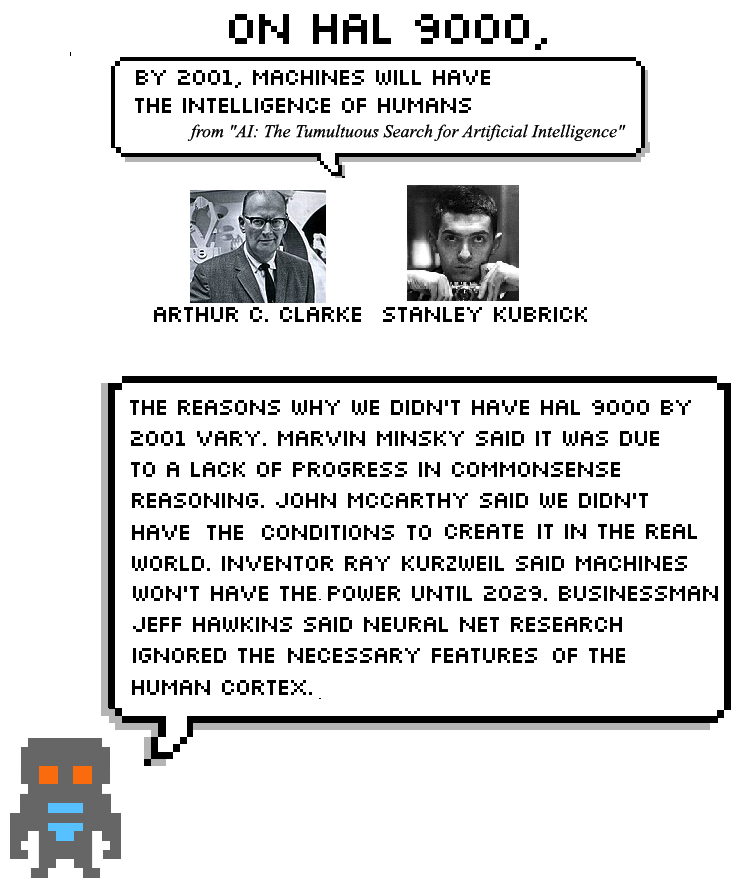By S. Hussain Ather
Jump to:
Information Age
Golden years
Modern history
Renaissance
Middle Ages
Antiquity


2019

Google’s AlphaStar defeated pro StarCraft II players. The artificial intelligence agent could process information about visible enemy characters and its own base while analyzing multiple parts of the map simultaneously.
2019
Google opened its first Africa Artificial Intelligence lab in Ghana. The Google AI Centre in Ghana would provide solutions to the problems the continent faces related to health care and agriculture.
2018
The AI Now Report 2018 by the AI Now Institute revealed unsafe and poor practices by IBM Watson, the U.S. Immigration and Customs Enforcement, the Xinjiang Autonomous Region, and Amazon’s Rekongnition tool. more…
2018
Artificial intelligence should be subject to scrutiny as it respects privacy and fosters thought. These were among the new norms and values brought upon by artificial intelligence, emphasized Christine Tappolet, a professor of philosophy at the Université de Montréal. They would form part of “The Montreal Declaration for a Responsible Development of Artificial Intelligence.” more…
2018

Mathematician and Member of the French Parliament Cedric Vilani released “For a Meaningful Artificial Intelligence: Towards a French and Euoprean Strategy,” his vision and strategy to make France a leader in artificial intelligence. He covered economic policy, agile research, impacts on employment, ecological concerns, ethical issues, and inclusive, diverse artificial intelligence.
2017

Philosopher and cognitive scientist Daniel Dennett warned of the dangers of artificial intelligence in From Bacteria to Bach and Back. It’s “possible in principle” to create human-like artificial intelligence, but any strong artificial intelligence would raise issues of comprehension. Superintelligence is not as significant as philosopher Nick Bostrom believes.

2015

The United States Special Operations Command put forward the idea of the TALOS (Tactical Asault Light Operator Suit), a robotic exoskeleton to augment the soldier’s senses.
2015
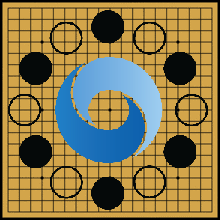
5- 0: Google DeepMind’s AlphaGo beat 3 time European Go champion 2 Fan Hui. Fan described the program as “very strong and stable, it seems like a wall. … I know AlphaGo is a computer, but if no one told me, maybe I would think the player was a little strange, but a very strong player, a real person” in Nature.
2014
Swedish philosopher Nick Bostrom argued that if machine brains surpass human brains in general intelligence, their Superintelligence could surpass humans as dominant life forms. More…
2014

The Talos Principle: Through the philosophical video game “The Talos Principle,” the player controls a robot and addresses metaphysical puzzles such as the difference between choices by humans and those by robots as well as whether reality exists or is merely a virtual simulation.
2011

IBM’s Watson defeated Jeopardy! champions Brad Rutter and Ken Jennings. Watson used over 100 different methods of reasoning including analyzing language and investigating hypotheses. In the years since, Watson gained the abilities to read and interpret information.
2009
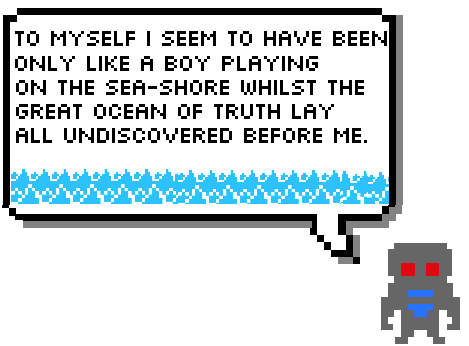
On the shoulders of giant robots: “Eureka machine” by Cornell scientists generated Newton’s three laws of motion in a few hours. It took years for scientist Isaac Newton to do so in 17th-century England.
1999
Carnegie Mellon roboticist Hans Moravec predicted that robots exceed humans by 2050. In his book Robot: Mere Machine to Transcendent Mind, the relationship and differences between humans and robots become muddled with dangerous implications of robots replacing humans.
1989

Mathematical physicist Roger Penrose argued in his book The Emperor’s New Mind a computer can’t re-create consciousness. Quantum mechanics, interactions of subatomic particles, plays an essential role in human consciousness and brain function.
1988
Moravec’s paradox explained that computers can easily prove theorems and solve mathematical problems that are easy for computers, but struggle with recognizing a face or moving around safely. It’s why vision and robotics sensorimotor research struggled so much during the 1970s and 1980s.
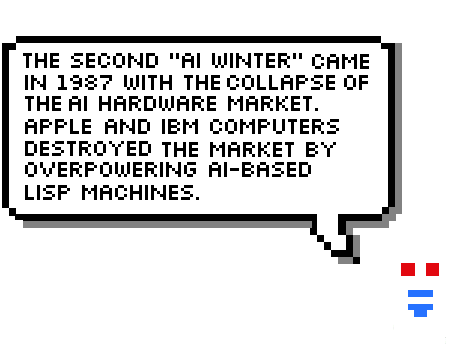
1986

Computer scientist Natarajan Shankar used the Nqthm theorem-prover to prove Gödel’s first incompleteness theorem. The incompleteness theorems prove that, if a computer can track a list of rules that can develop the basic laws of mathematics, then the list can’t be both consistent and complete. These theorems are among the few that computers can verify.
1986

Psychologists David Rumelhart and James McClelland introduced parallel distributed processing to use artificial neural networks to explain psychology. They emphasized the parallel nature of neural processing and the distributed nature of neural representations
1982
Physicist John Hopfield and psychologists Geoffrey Hinton and David Rumelhartm made discoveries that revived connectionism, a method of explaining mental phenomena by simulating neural networks. Hopfield proved “Hopfield nets” could learn and process information in new ways while Hinton and Rumelhart found new methods to train neural networks.
1980

Research scientist Kunihiko Fukushima published his work on the neocognitron, a deep convolutional neural network. Convolutional networks recognize visual patterns, and the neocognitron self-organized to recognize images by geometrical similarity of their shapes regardless of position.
1980

Philosopher John Searle formulated the Chinese room argument to discredit the idea that a computer can be programmed with the appropriate functions to behave the same way a human mind would. more…
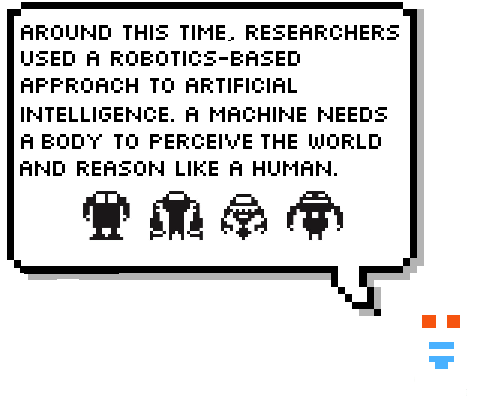
1980

The father of expert systems, computer scientist Edward Feigenbaum developed a computer that makes decisions as a human can. They use rules to reason through knowledge. more…



1972

“Domo arigato, Mr. Roboto”: Waseda University in Tokyo created the android WABOT-1, or WAseda roBOT, the first full-scale intelligent humanoid robot. It could walk, grip objects, speak Japanese, and listen. It could measure how far away it was from certain objects using its vision and auditory senses.
1970

Japanese robotics professor Masahiro Mori coined “Uncanny Valley” to describe the “strangeness” of the emotional response to human-like robots. more…
1966

PhD student at Carnegie Mellon University Ross Qullian showed semantic networks could use graphs to model the structure and storage of human knowledge. Quillian hoped to explore the meaning of English words through their relationships. more…
1965
Philosopher-mathematician Alan Robinson created the Resolution method that let programs work efficiently with formal logic as a representation language in solving mathematical proofs.
1965

MIT computer scientist Joseph Weizenbaum created the computer program ELIZA, named after Eliza Doolittle of George Bernard Shaw’s play Pygmalion. While Doolittle was taught to speak in an upper-class English accent, ELIZA communicated in English on everything and even simulated a psychotherapist dialogue.
1965
Philosopher-mathematician John Alan Robinson created the complete algorithm for logical reasoning. It let computers solve equations and test arguments with symbols such as + and →.
1964
Philosopher John Lucas argued that Gödel’s first incompleteness theorem entails no computer can reach human-like intelligence in his paper “Minds, Machines, and Gödel.” For any automaton, there’s a mathematical formula it can’t prove, but a human can.
1963

John McCarthy started Project MAC, which would later become the MIT Artificial Intelligence Lab. The research would contribute to cognition, computer vision, decision theory, distributed systems, machine learning, multi-agent systems, neural networks, probabilistic inference, and robotics. Later that year, McCarthy and Marvin Minskey launched SAIL: Stanford Artificial Intelligence Laboratory. The research institute would pave the way for operating systems, artificial intelligence, and the theory of computation.
1959

Economist Herbert Simon, programmer J. C. Shaw, and computer scientist Allen Newell create the General Problem Solver based on logic machine architecture. It solved basic problems, but suffered from similar issues as other research in the golden years. There was an astronomical number of combinations by which a computer could search space through heuristics.
1956

Computer scientist John McCarthy coined the term “artificial intelligence” at the Dartmouth College Summer Research Project on Artificial Intelligence, organized by McCarthy, cognitive scientist Marvin Minsky, computer scientist Nathan Rochester, and mathematician Claude Shannon. This ushered in the golden years of artificial intelligence.

1955

The Logic Theorist (LT), the first running artificial intelligence program, demonstrated by Allen Newell, J.C. Shaw, and Hertbert Simon at Carnegie Institute of Technology. Newell and Simon began to create the Logic Theorist before the existence of the field of artificial intelligence itself. more…
1950

English philosopher-mathematician Alan Turing created the Turing Test to ask, “Can machines think?” in his paper “Computer Machinery and Intelligence.” Two years later, in a BBC Radio Broadcast, Turing considered a similar problem of whether a jury could ask questions to a computer such that the computer would respond to convince them it is really a person. more…
1950

Writer Isaac Asimov published I, Robot to share themes of human-robot interactions. In the stories, “robopsychologist” Dr. Calvin created robots and studied how they behaved in comparison to humans.
The collection of stories also contained the three laws of robotics:
- A robot may not injure a human being or, through inaction, allow a human being to come to harm.
- A robot must obey orders given it by human beings except where such orders would conflict with the First Law.
- A robot must protect its own existence as long as such protection does not conflict with the First or Second Law.

1950

“Programming a computer to play chess” published by mathematician Claude Shannon. Shannon would become the “father of the information theory.”
1945

How to Solve it by mathematician George Poly: this book introduced the term ‘heuristic’ into modern thinking. Computer scientists, philosophers, psychologists, and other scholars would describe heuristics as rough methods of reasoning – human or computer.
1944

Mathematician-physicist John von Neumann and economist Oskar Morgenstern introduced game theory, or how artificial intelligence makes rational decisions, in their book Theory of Games and Economic Behavior. Teaching computers to play chess and maximize values would lead to innovation in both computer science and economics.
1943

Scientists Warren McCulloch and Warren Pitts developed the first artificial neuron, a mathematical model of a biological neuron. It would later become fundamental to neural networks in the field of machine learning.
1940

Nuclear scientist Edward Uhler Condon created the Nimatron, a computer that played Nim and one of the earliest examples of artificial intelligence in video games. Over 50,000 people played it over six months while only a few beat it. Digital logic as a toy would become central to artificial intelligence in video games.
1939
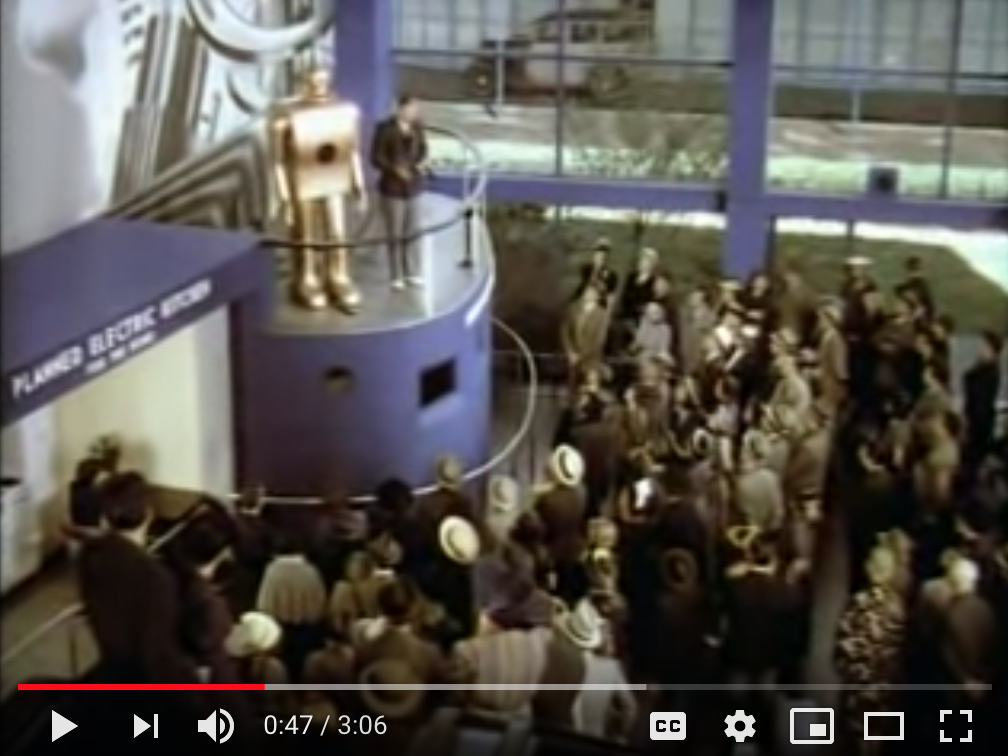
Westinghouse Electric Corporation unveiled Elektro the robot that could walk, talk, and smoke cigarettes.

1936
English philosopher-mathematician created the Turing Machine, a device consisting of a tape, an infinite line of cells, and a head, an active element that moves along it. Turing Machines are abstract devices to simulate logic and test theoretical ideas about the potential of computers. more…
1920

Czech writer Karl Čapek wrote the science fiction play R.U.R., Rossumovi Univerzální Roboti (Rossum’s Universal Robots), which introdcued “robot” into English. In the play, a factory makes robots, artificial people of flesh and blood, that rise up to destroy the human race. It reflected the Fordist assembly line and fears post-World War I. Though these were not mechanical beings, “robot” would replace “automaton” and “android” in many languages.
1913
Principia Mathematica by mathematicians Bertrand Russell and Alfred North Whitehead revolutionized formal logic. It laid the foundations for type checking and type inference algorithms later used in theorem-proving computers and formalized mathematics in computer programming lunges.

1912

Spanish mathematician Leonardo Torres y Quevedo built the first computer game, El Ajedrecista (The Chessplayer), which used mechanical arms to move chess pieces. Though it didn’t use the minimum number of moves to win, it did aim for an endgame of three chess pieces. It would then move a white king and a rook to checkmate the black king moved by a human opponent. After spending years speculating about how automata could think like humans, he replaced the arms with electromagnets in 1920.
1900

Artificial emotion: American author L. Frank Baum wrote The Wonderful Wizard of Oz, in which the Tin Woodman desired a heart through his philosophical debates with the Scarecrow and the Cowardly Lion. Though he lacked a brain, Woodman cared much more about having no heart. Despite this shortcoming, he displayed tender emotion much more than Dorothy’s other companions.
1881

Italian authorist Carlo Collodi published “The Adventures of Pinnochio” through stories in the magazine Giornale per i bambini. He shared the story of a toy with emotions and judgements yearning to become human.
1863

English author Samuel Butler speculated machines would evolve like humans and overtake them as a superior race. Influenced by biologist Charles Darwin’s 1859 work On the Origin of Species, Butler’s letter to a New Zealand newspaper The Press outlined the themes of an explosive technological change. It would create a singularity in which computers overtake humans, similar to philosopher Nick Bostrom’s superintelligence.
1822

Mathematician-philosopher Charles Babbages invented the difference engine, a calculator that performed functions and calculate values automatically. Though it didn’t work as well as Babbage had envisioned, it laid the foundation for automated computation.
1818

Frankenstein by novelist Mary Shelley: with philosophy, literature, science, and history, Shelley speculated how humans would attempt to use scientific progress to tamper with nature. Frankenstein and his rejected monster remain central to debates about fetal tissue research, life extension, human cloning, and artificial intelligence. more…
1804

Jacquard loom, the first programmable machine, invented by merchant Joseph-Marie Jacquard using instructions on punched cards. These mechanical devices output a series of punched cards. Creating new patterns and cards were precursors to computer programming and data entry. Mathematician-philosopher Charles Babbage knew of Jacquard looms and planned to use cards to store programs in his Analytical Engine.
1796

Japanese craftsman Hisashige Tanaka created mechanical toys that served tea, fired arrows, and painted Japanese kanji characters. The dolls would even bow in Japanese tradition. People used them in their homes and during religious festivals. He outlined these automaton in Karakuri Zui (Illustrated Machinery). The word “karakuri” means “trick or “mechanisms” in showing the awe it evoked, similar to the sebas (awe) the ancient Greeks described.

1770

Hungarian inventor Wolfgang von Kempelen created the Mechanical Turk, in which a human would hide inside a machine to make it appear as though an automata were playing chess and fool Empress Maria Theresa of Austria.
1750
French physician-philosopher Julien Offray de La Mettrie argued only the mechanical workings of the brain govern cognition in L’Homme Machine. This mechanistic realism countered Descartes’ duality of the mind and body. Complicated physical interactions in the brain governed thought. This meant humans behaved like machines, but also very much like other animals.
1673

French philosopher-mathematician René Descartes wrote, in Discourse on the Method, automata can’t respond to things the way a human can. This concept of what humans have the machines lack would serve the basis for the Turing test. As he studied physics and theology, he believed mind and body are separate. more…
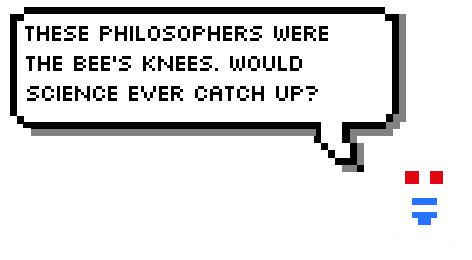
1641

English philosopher Thomas Hobbes presented a materialistic explanation of the mind. Describing thinking and cognition as mechanical sums of physical processes, similar to the way robots, automata, androids, and other forms of artificial intelligence think.
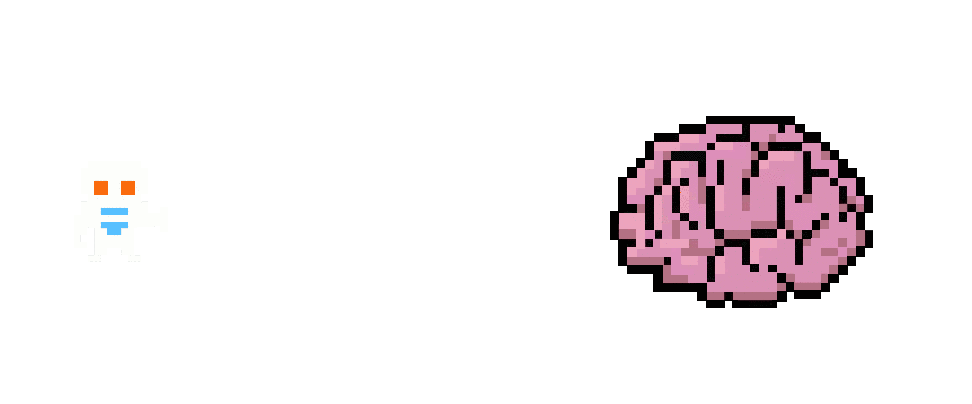

1596

In his poem, “The Faerie Queen”, English writer Edmund Spenser described the invincible, incessant Iron Knight Talus robot going on a killing spree. The story posed questions such as whether morals can be interpreted through mechanized processes and whether machines can understand justice and compassion. Such an “artificial moral agent” (AMA) would continue to take place in debates among ethicists and scientists for centuries.
1533

In 1533, German mathematician-astronomer Johannes Müller von Königsberg, more commonly known as his Latin pseudonym Regiomontanus, built an iron automata eagle that could fly. Historical records are sparse, but, by one account, the eagle greeted and followed a visiting emperor.
1495

Italian Renaissance polymath Leonardo da Vinci showed his “mechanical knight.” Researchers at the University of California have speculated the significance of some of da Vinci’s markings by reading his technical drawings. Using pulleys and cables, the “knight” would move its arms and legs like a human.
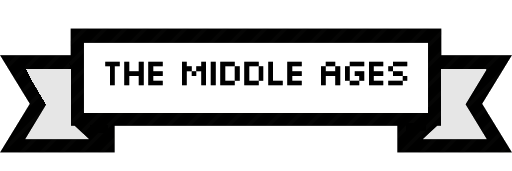
1200s

Majorcan philosopher-mathematician Ramon Llull developed logical machines devoted to combine basic, undeniable truths by simple logical operations. They were produced by the machine by mechanical meanings, in such ways as to produce all the possible knowledge. The “Lullian Circle” was a paper machine that rotated circles to combine symbols with one another. Llull’s work had a great influence on philosopher Gottfried Leibniz, who argued mechanical calculation can amount to reasoning.
1206

The first programmable humanoid robot invented by polymath Al-Jazari: a water powered boat that carried four mechanical musicians. With a drum machine of pegs knocking on other bars, computer scientist Noel Sharkey re-created the mechanism by which they operated. Sharkey also argued it was likely an early programmable automata.
Medieval Europe
Medieval Europeans created brazen heads, talking automaton that could speak phrases like “Time is. Time was. Time is past.” German Catholic bishop Albertus Magnus constructed an android that performed domestic tasks, philosopher Thomas Aquinas destroyed it for disturbing his work. According to legend, English philosopher Roger Bacon created a head that could answer any question.
Talmudic period

Jewish writers studied the Sefer Yetzirah, the Book of Creation, to bring golems to life. They believed they could infuse life to golems, rock statues, by writing a name of God on paper and inserting it into a golem. Jewish philosopher-poet Solomon Ibn Gabirol created a maid this way. When the king wanted to punish him for this, Ibn Gabirol showed the maid wasn’t real by turning it back into rock. Golems would continue to serve an automated force in Jewish tradition representing villains or heroes and hope or despair.
~800

Arab polymath Jabir ibn Hayyan, more commonly known as Geber, created the Muslim alchemical goal of “Takwin” to artificially create human life. It was a way to copy God’s divine power. This had roots in Islamic belief, but also in both magic and alchemical science. He even used an alchemical system of symbols to communicate his work.

Antiquity

Greek myths of Hephaestus and Daedalus incorporated the idea of intelligent robots and artificial beings like Pandora. These “automaton” beings such as Talos would protect Crete from invaders. Ancient Greeks spoke of the idea of ‘biotechne’, or how biological phenomena such as aging can be altered with technology of humans. Through their myths and stories, scholars wrestled with what it meant to be human and how man can push his biological limits to what he can give life to. more…











